#mid 16th century
Explore tagged Tumblr posts
Text

The Mary Rose, by Geoff Hunt (1948-)
109 notes
·
View notes
Photo

Collection of portraits of Saxon princes and princesses with rhymed text ; from 1500 - 1546
#16th century#mdp16th c.#Illustration#early 16th century#German Style#mid 16th century#germany#16th c. germany#mdpillustration
128 notes
·
View notes
Text

submitted by @myryathedreamer 💚💜
#new century for the blog hell yeah!!!! 😎😎#historical fashion poll submission#very historical historical fashion polls#historical fashion polls#fashion poll#historical dress#historical fashion#dress history#fashion history#fashion plate#16th century#1500s#1540s#mid 16th century#mid 1500s
45 notes
·
View notes
Text





✨New From Wulflund✨
Mid 16th Century Gothic Flanged Mace (APW102) is finely styled in gothic fluting and angular styling and its all steel construction is durable.
Eastern European Medieval Flanged Mace (APW100) has a large and robustly crafted head of antique finished high carbon steel which is securely pinned and mounted to a thick hardwood haft.
Corvus Warhammer (ETC01) has all the tools at hand needed to defeat and mangle the heaviest of armors; when wielded by a capable hand it combines the concussive and shattering power of an all steel hammer head with a large armor-puncturing pick.
Thor’s Hammer (APW64) This huge warhammer is a fitting size for Thor himself and a larger than life centerpiece to a collection. This burly weapon fit for a Saga has a head that is crafted from plates of steel which are welded together to keep the inside of the hammer hollow to ensure it is weighty, but not excessively so.
Partisan Head of Frederick Augustus I (APW121) is a replica of the ones used by the court guards of Elector Frederick Augustus I (1694 – 1697) and is a fine example of the late form of the Partisan. It is crafted from high carbon steel and its socket measures approximately 1″ / 26 mm and is intended to attachment to your own haft which is tapered and tailored to fit.
#Kult of Athena#KultOfAthena#Wulflund#Mid 16th Century Gothic Flanged Mace#Eastern European Medieval Flanged Mace#Corvus Warhammer#Thor’s Hammer#Partisan Head of Frederick Augustus I#War hammers#Hammers#Partisan Head#Spears#Pole Arms#SPEARS & SPEARHEADS#Spears & Spearheads#Maces#weapon#weapons#16th century#Viking#Vikings#Mjölnir#Mjolnir#Viking Weapons
10 notes
·
View notes
Note
if you could time travel to any period in the past, just to observe you cant interact with anything, where would you go
ouuugh in the past? probable late 1890s or 1900. also maybe somewhere in 1920-30s but not past that point.
something something is very special to me in how one era of industrial progress and the way of living evolved into another (and very different!) one. and 20th century has its own unique charm for me, so
1 note
·
View note
Text
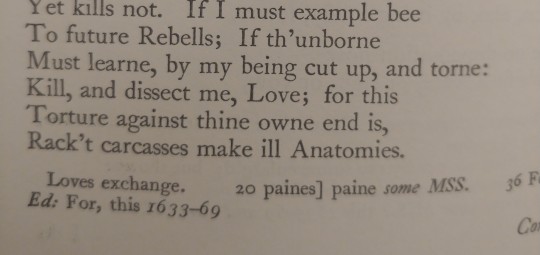
really delightful to realize that like yeah folks have always been fucking unhinged about love.
#john donne in the mid 16th century: KILL ME!!! KILL ME AND DISSECT ME AND PIN MY TWISTED CORPSE UP AS A WARNING!!#me today: god he would have done numbers.#txt
1 note
·
View note
Text

Rapier with gold and silver decorated hilt, blade crafted by Peter Wirsberg of Solingen, Germany. Hilt decorated by Diego de Caias of Milan, Italy. Mid 16th century
from The Dresden National Art Collection
740 notes
·
View notes
Text
15th century (Houppelande the Ritz)

Early 16th century (God please, not the codpiece)

Late 16th/early 17th centuries (That's ruff, buddy)

Mid-17th/early 18th century (If it ain't Baroque, fix it)

Mid-18th century (Big tent party)

Late 18th/early 19th century (Empire state of mind)

Mid-19th century (Hoop springs eternal)

Late 19th-early 20th century (Hustle and bustle)

1910-20s (Ankles aweigh)

#yes the divisions are wonky don't @ me#as for the puns I can only apologize#fashion history#hot takes
1K notes
·
View notes
Note
I LOVE your art!! especially the very specific ways to depict intimacy. It feels very real, it's so so tender but there is often that sheer layer of tension that makes me want to consume as much as your art as possible. I hope I'm not bothering ypu, but what's the porch of your two characters? I love them, I love their dynamic.
Aa thank you for your kind words! I'm glad you like my stuff :>
You probably mean my current main characters, Vasco (the golden floppy-eared dog) and Machete (the pointy white dog). They're a couple living in the late 16th century Italy, at the very end of the Renaissance era. Vasco comes from a wealthy noble background and has a career in politics. Machete is a catholic cardinal, and as a secretary of state he oversees Vatican's foreign politics. Due to their surroundings they have to keep their relationship strictly secret.
Vasco originates in and lives in Florence. Machete is originally from Sicily and lives in Rome. They first met in their late teens/early adulthood when they were both studying in Venice. They were best friends before their feelings deepened, but eventually they had to separate. Machete graduated and was ordained a priest as intended. Vasco dropped out and returned home, where his family pressured him into wedlock. He ended up in a lavender marriage with a lesbian noblewoman named Ludovica (the red and white spaniel), she also has her own partner (still unnamed). Vasco and Ludovica are close friends, they get along well and cover each others' backs, but their union is purely platonic.
Machete and Vasco reunited in their early thirties by random chance, largely because they both work in foreign relations, and quickly resumed where they left off. They don't live together and can only see each other intermittently. Usually it's Vasco who visits Machete in Rome under the guise of working as a Florentine ambassador, but sometimes Machete manages to find an excuse to travel to see Vasco as well. They stay together for over a decade, meeting in secret and maintaining regular correspondence when their duties keep them apart (and quietly come to regard each other as their spouse), until Machete gets assassinated in his early/mid fourties. Vasco lives to his seventies and dies of old age.
They also have a modern au, which works as a sort of a reincarnation situation. They get to be a couple openly, get married eventually and grow old together.
#answered#topsheepstudent#this is such a clunky and inelegant explanation sorry#you can take a look at the#Vaschete lore#tag if you want to read more ramblings about them and their story#they keep sprouting new aus#one being the cowboy au#there's the kid named ear au#and the recent minmax au which follows the canon except this time Machete manages to kill the assassin who was supposed to murder him#and uses his body to fake his death#escaping his doomed by narrative fate and either relocating to Vasco's estate or running away with him
327 notes
·
View notes
Text
Sewing mid-16th century Venetian dress in doll scale - Part 2
I mentioned in the first post that I was meaning to do sleeves for the dress, but lost my patience after failing at it, so I decided to let it go for now. Well, for now has gone and I finally did it after failing couple of more times. I also made a new chemise for the doll (which I also made a free pattern for), since I wasn't happy with the first one and I'm much happier with the second attempt. So without further ado, here's the Venetian Renaissance doll finally finished.
First the new chemise.


Then the new chemise with the dress.


And finally the whole dress!





After all the struggle I'm quite happy how the sleeves turned out!
#historical costuming#historical fashion#renaissance fashion#my art#historical sewing#dolls#my dolls#dress history#dollblr#fashion dolls#doll clothing#custom doll
424 notes
·
View notes
Text

Hose, Doublet and Rock of Elector Moritz von Sachsen, 1545-1550
Starting the new year with one of the most expensive and glorious extant suits of the 16th century: this golden silk dress of Elector Moritz.
Made just a couple of years before he died in battle, this suit features tight fitting hose made of leather, silk and velvet, a silk doublet with pinked sleeves, and a Rock/Gown made of golden silk and black velvet - the colours of Saxony. The silhouette of this suit is typical for the mid 16th century: low waist, broad shoulders. That´s also why so many men of that period look like Henry VIII - they all shared the same fashion. The suit is currently exhibited at the Rüstkammer in Dresden, Germany.
#historical fashion#16th century#historical costuming#renaissance#renaissance fashion#16th century fashion#fashion history#history#saxony
200 notes
·
View notes
Text
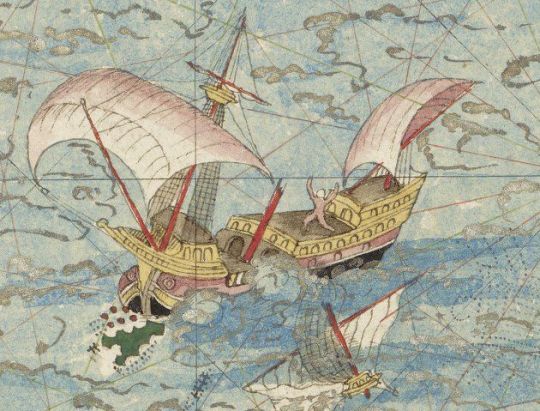
A French Galleon from Guillaume Le Testu's Cosmographie Universelle 1555
42 notes
·
View notes
Text
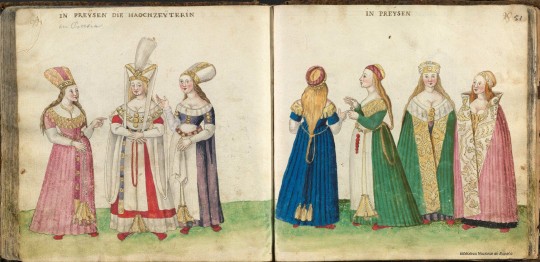
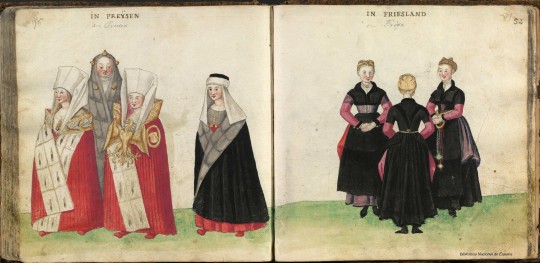
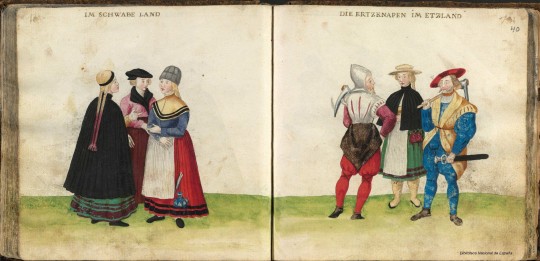
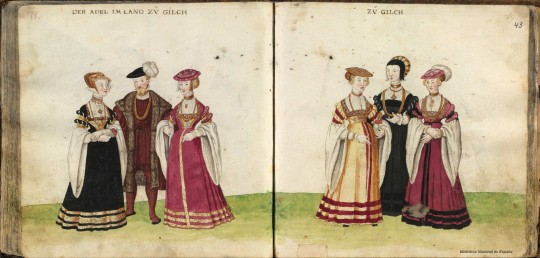
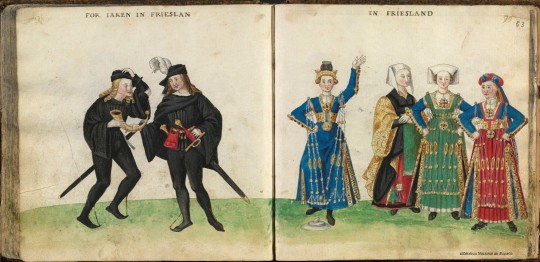
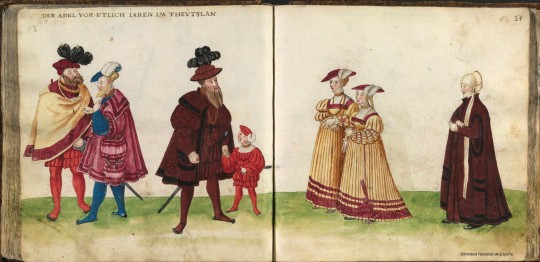
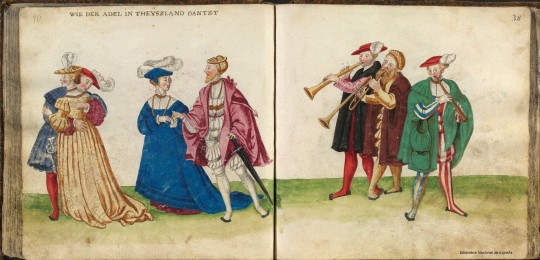
Códice de Trajes, costumes from the realms of Charles V, Holy Roman Emperor and King of Spain, made in Germany in mid 16th century (1540s-1550s)
Prussia
Prussia and Friesland
Schwabia and Elzach
Juelich
Frisia
Germany
German dance
#germany#manuscript#16th century#mdpillustration#illustration#costume illustration#1540s#1550s#holy roman empire#16th c. holy roman empire#prussia#mid 16th century
429 notes
·
View notes
Text



Mid 16th Century Gothic Flanged Mace – Wulflund
This Gothic Flanged Mace is more robustly built than most and it has the heft needed to powerfully smash and batter asunder even the heaviest of armored defense. The mace is finely styled in gothic fluting and angular styling and its all steel construction is durable. Unlike cruder maces, a gothic mace such as this was a finely crafted item intended to deliver destruction from the armored fist of a knight or professional man at arms.
Please Note: Some light pitting or light spotted rust may be present. Most of this cosmetic blemishing can be removed with scuff pads
#Kult of Athena#KultofAthena#New Item Wednesday#Mid 16th Century Gothic Flanged Mace#Wulflund#Mace#Maces#Weapon#Weapons#Flanged Mace#16th century#Battle Ready
1 note
·
View note
Text
What Rank did Michikatsu [Human Kokushibō] Hold as a Samurai?
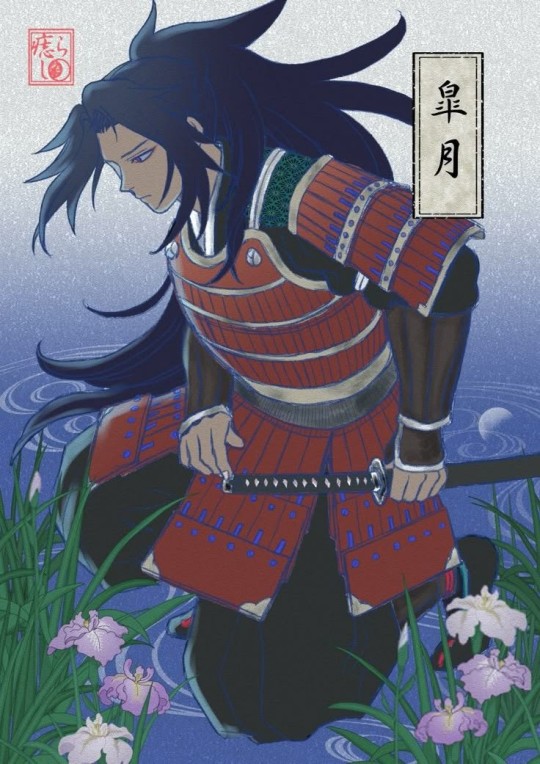

When we think of a samurai, we often envision a fierce warrior prepared for battle. While this is partly true, we often tend to forget the internal heirarchy among them. Like any military group, samurai had a clear chain of command for smooth operations. However, it's important to note that samurai were a social class rather than a military one.
These "ranks," or more so, distinctions within the samurai were closely tied to hereditary social status, the extent of land ownership, and titles within the clan, rather than personal skills, which could vary depending on the era.
In this discussion, we will concentrate on the Sengoku era, as it is relevant to our topic. I will examine Michikatsu's role based on the available canonical information.
⚠ SPOILERS AHEAD ⚠ | Masterlist

⨳ Where His Father stood

In the image above, Michikatsu talks about his father having a "vassal." A lot could be inferred from this, but it is likely that his father either might be a samurai lord [Sengoku daimyo] or a wealthy, high-ranking samurai who supports smaller samurai.
[Daimyo (大名): military lords who controlled small, unified areas in which all the land either belonged to themselves or was held in fief by their vassals] [Vassals: subordinates who pledged their loyalty and obligations towards powerful lords]
So essentially, he was not just an ordinary samurai but rather a figure of considerable importance. His possession of vassals and land suggests that he must be exercising some form of governance, implying that he is possibly some sort of lord having an independent clan.
As you can see, he seemed to have personal servants:

And also personal messengers:
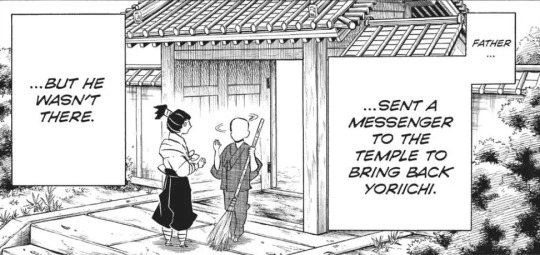
Though it is rather difficult to tell whether he was a powerful lord or not—an actual daimyo who was the direct vassal of the shogun, or just a lesser lord having a smaller land—possibly a heir to the family head or a landowner with a fief.

⨳ Was The Tsugikuni Clan Powerful?
First, let us understand what was going on during that time:
"This was the 'Age of Warring States', when scores of minor daimyo seized power for themselves in their immediate localities and fought each other until, during the mid-16th century, a comparative handful of 'super-daimyo' competed with each other on a grand scale before Japan was finally reunified" [source]
From this, it seems logical to assume that the Tsugikuni clan was a smaller one rather than a grand one—also considering Michikatsu's father's rather obsessive nature and his intense determination on getting better heirs, even to the point of being willing to harm his own family due to superstitious beliefs. Better heirs: more likely the clan gets to thrive and gain power.
Also, if we consider these words from Kokushibou:
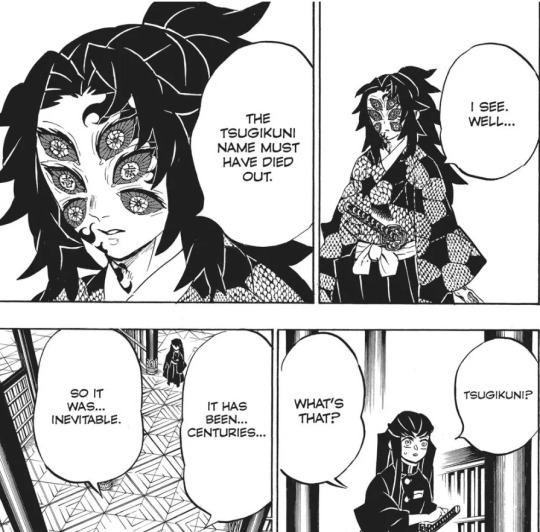
Notice how he says this—he doesn't seem to be very surprised to know that his clan's name has died out, which would only solidify the fact that his clan must not be very powerful to begin with. [Considering that many direct descendants of the major clans today still seem to be thriving, with many carrying out their clan names. Muichiro seems to be an exception here]
So now that we know that his clan was likely not a powerful one, we could also assume that his father was a local lord rather than a full on daimyo for obvious reasons. Not only that, but this would also suggest that their clan must be a retainer family—they would be under a much stronger lord—a powerful daimyo, whom they would had to serve.

⨳ MICHIKATSU'S POSIBBLE RANK [DISTINCTION]
Before moving on, I would just like to point out that holding a high-ranking position as a samurai—such as leading troops— was a result of personal achievement rather than mere familial ties. If a family did not meet the necessary standards of talent and capability, their members would be assigned to lesser roles based on who they served.
With that being said, let us now try fitting in Michikatsu into all of this and find out what military rank he should have based on his family background:
Initailly, I was rather confused and wondered if Michikatsu could be a Hatamoto. They were the highest ranking samurai, considered the most loyal and skilled, who acted as bodyguards towards their lord. Sounds familiar, right? However, there was one piece of canon information that completely debunked this idea:

Samurai usually had to chop off their enemy’s head as proof of their kills; typically that shouldn't be done by the hatamoto, as they typically stayed close to their lords as a last resort instead of fighting on the front lines like the others.
Okay.. so he probably isn't a hatamoto. If his first instinct was to bring the head of Ubuyashiki to Muzan, then it suggests he must have done this before. if that's the case, then he must have ranked lower than a hatamoto, more so in a class where he might have been around collecting heads. After looking into what the manga could offer, I reached two conclusions:
1. He was a Taisho (大将)[general]: These ranked officials were the generals in the Daimyo's army, leading groups of soldiers called kumi. Depending on the troops they commanded, they were either referred to as Samurai-taisho or Ashigaru-taisho. They usually oversaw multiple kumi, each consisting of around 50 to 100 men.
2. He was a Kumigashira (組頭) [captain/platoon commander]: These officers controlled and led a single kumi of troops and were called samurai-kumigashira or ashigaru-kumigashira based on the type of troops in their kumi; which, often consisted upto 15-30 men each.
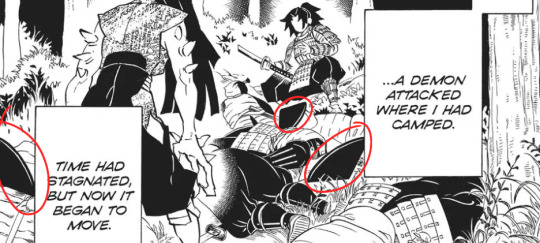
-> By those conical hats (jingasa) those men are wearing, I'm pretty sure they are depicted as Ashigaru foot soldiers. [This explains why he refers to them as his subordinates, as ashigaru were considered lower than samurai.]
Looking at the image, I doubt there are 50-100 men present there, and it seems more likely there are about 15-30. Therefore, we can conclude that he must be an Ashigaru-kumigashira.
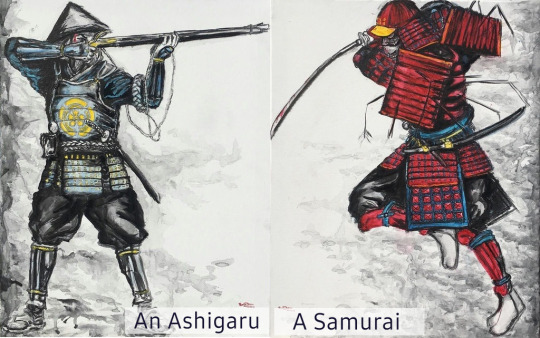
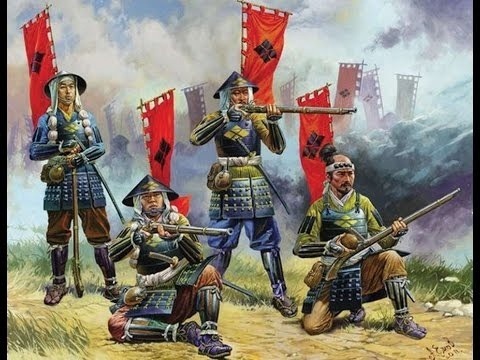
Also, when people talk about Ashigaru, they usually think of peasants taken out of their farms. This is a misconception. Even though they were lower in class, ashigaru were generally treated as full on warriors. Not only were they as capable as their samurai counterparts, some were even stronger than them.The men under Michikatsu's command were fully capable and skilled swordsmen.

⨳ Michikatsu's Troops and His Role:
A general overview of the make up of the sengoku era army
—In short, the troops were reorganised in Sonae, which had between 300 to 800 men. Each Sonae included various types of troops. They were split into smaller units called Kumi, based on their weapons. These included archers, gun squads, cavalry, spear squads, and standard bearers.

By looking at these images, I see no one holding weapons, just a few casual swords thrown in here and there, which I find to be very odd..
Perhaps Michikatsu had set up his base further from his soldiers and gathered them up for a speech about the next day's plans just before they went to sleep? This could explain why they were caught off guard by the demon and didn’t have their weapons ready. After all, it’s strange not to have your weapons out when you are being attacked.
Regardless of the situation, his troops should be either a spear unit [Yari-gumi (長柄組)] or an archer unit [Yumi-gumi (弓組)].
These troops Consisted of: 1 samurai commander/katana samurai, 2-4 servants, ~20-30 foot soldiers, 3 labourers, 1 cavalry horse, and 2 packhorses.
Why you ask? This is because, firstly; guns weren't introduced until the mid sengoku period in 1543 [Michikatsu is theorised to be born around 1432] In the cavalry unit, the troops consisted of samurai rather than ashigaru, and bannermen did not engage in battle.
MICHIKATSU'S ROLE: Although there is not much provided anywhere about these commanders, from everything I have gathered: These commanding officers used to lead a unit of ashigaru soldiers. They were ranked below the sodaisho and samurai daisho (commanders) and an ashigaru taisho.
He would be assigned to train them, discipline the foot soldiers, and turn uneducated common men into reliable warriors. He would command and lead them, ensuring everyone followed his commands and maintained order within the ranks, and not disrupt the hierarchy. Hmm that sounds familiar doesn't it?
[I might actually make a detailed post about the military formation with Michikatsu if any of you are interested.]

Final thoughts:
[A/n: Hello everyone! It's been a while since my last post. No, I haven't abandoned my blogs. I just took a short break last week. Now I'm back and eager to share a theory with you all! Which I will be posting more of, both here and on my other blog, @gilded-sunrays. Please feel free to share your insights!]
And if you've made it through all of this, then I thank you wholeheartedly!


#「ᴛʜᴇᴏʀɪᴇꜱ & ᴀɴᴀʟʏꜱɪꜱ」#Kokushibo#Sengoku era#Tsugikuni clan#Michikatsu Tsugikuni#Kny sengoku era#Michikatsu#tsugikuni michikatsu#Kokushibo analysis#Michikatsu analysis#Kny analysis#Kny nerdery#kny reference#kny fandom theories and meta#kokushibou#kokushibo demon slayer#demon slayer kokushibo#demon slayer#kimetsu no yaiba#kny kokushibo
206 notes
·
View notes
Text






JULES-LOUIS MACHARD; "ANGELICA ATTACHED TO THE ROCK," 1869
The painting illustrates a moment from the epic poem "Orlando Furioso," featuring Angelica, a princess of extraordinary beauty from Cathay, tied to a rock as an offering to a sea creature. The tale is reminiscent of the myth of Andromeda and Perseus, especially the part where a woman is bound unclothed to a rock in the ocean as an offering to a sea beast, and is saved just in time.
Angelica plays a crucial role in Ludovico Ariosto's epic poem "Orlando Furioso." Orlando, the Christian hero, is among the knights pursuing her. The tale starts with her breaking free from her brother's protective hold and making her way to Charlemagne's court, sparking intense rivalry among the knights vying for her love. As the story progresses, Angelica is kidnapped and tied to a rock to be sacrificed to a sea monster named torc. The knight Ruggiero ultimately saves her by using a magical ring for her protection. Angelica, after experiencing many adventures and romantic relationships, ends up falling in love with Medoro, a wounded soldier, and they elope together. The realization of their marriage sends Orlando into a state of madness.
"Orlando Furioso" gained instant popularity in the mid-16th century, with some Italian critics pointing out that the poem did not follow Aristotle's unity of action, as it contained several plots instead of one main storyline. Some believed that it did not have a coherent structure. The defenders of the poem argued that it was not a classical epic but a romanzo, a genre that Aristotle did not recognize; hence, his criteria was not applicable.
157 notes
·
View notes